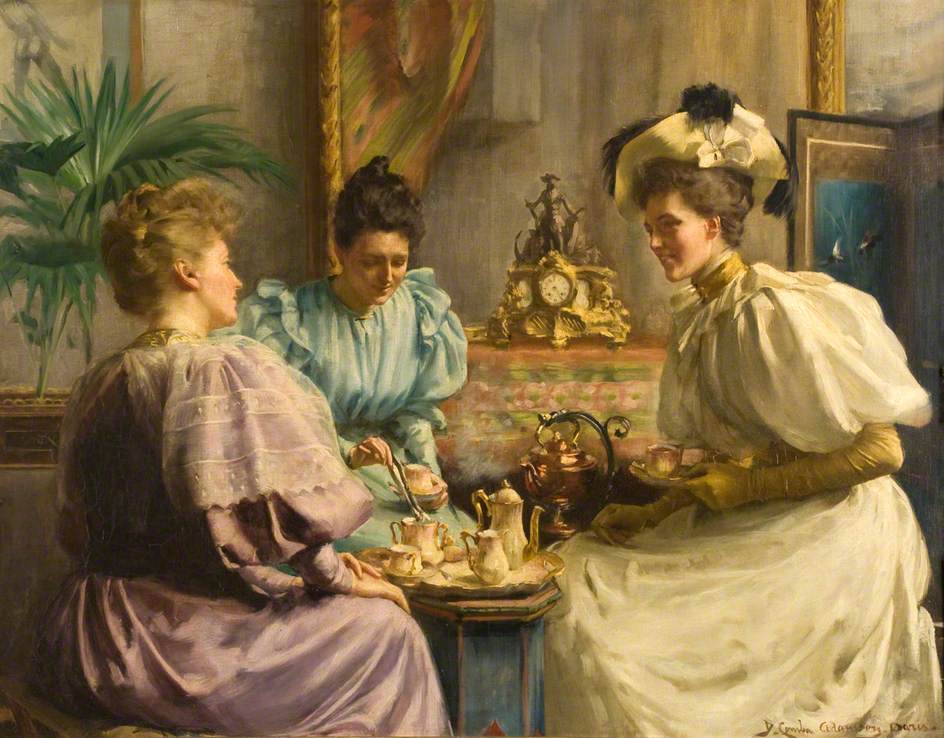Table of Contents
- The Quiet Strength of a Portuguese Princess
- Princess Catherine Brings Tea to England
- Thomas Twining and the Establishment of Tea Rooms
- Afternoon Tea
- Devonshire Tea
- But Is It Cream Tea, Devon Cream Tea, Cornish Cream Tea, or Devonshire Tea?
- The Difference Between Cornish Tea and Devonshire Tea
- How to Make Devonshire Tea
- How to Make Scones
- How to Make Easy Clotted Cream
- What Teas to Pair with Devonshire Tea
The journey from England's first introduction to tea in the mid 17th century to the delight we know as Devonshire Tea today was history in the making and now a pillar of 21st century British tea-drinking culture that is enjoyed all over the world.
The Quiet Strength of a Portuguese Princess

Princess Catherine of Braganza of Portugal was the picture of quiet, faithful, and enduring strength.
Her hand in marriage to Charles II in 1662 was given to secure mutually beneficial trade agreements between Portugal and England.
She had little experience of the world, having been brought up almost solely in the confines of a convent close by the royal Portuguese palace.
In spite of Charles II's little interest in Princess Catherine and his many dalliances, Princess Catherine held herself by his side in perfect esteem, even after being forced to live in close quarters with his many mistresses.
With time, her disinterested husband grew to honour her with such intensity, that he defended her against his mistresses when they did now show her the respect she was due.
Even when he was widely pressured to divorce her after she was unable to bear children, he defended her position in the palace.
They remained together for the duration of their lives, growing in mutual fondness, sharing heartfelt last words as Charles II passed away in 1685.
Princess Catherine Brings Tea to England
 In spite of Princess Catherine's extremely sheltered upbringing, the princess had become accustomed to tea-drinking, which was widespread among the Portuguese nobility.
In spite of Princess Catherine's extremely sheltered upbringing, the princess had become accustomed to tea-drinking, which was widespread among the Portuguese nobility.
At the time of her marriage to Charles II in 1962, little was known about tea in England.
The moment the princess arrived in Portsmouth on 13 May 1662, after a long and stormy crossing, she asked for a cup of tea. She was offered ale instead, which did not agree with the princess.
Over time, Princess Catherine established herself in the English court and became something of a trendsetter.
Although she embraced English fashions, her taste for food remained in her origins, including her love for tea. Soon her taste for tea had caused a fad at the royal court. This then spread to aristocratic circles and then to the wealthier classes.
Not surprisingly, the reign of Charles II then established the foundations for the tea-trade though east of Africa and west of South America to Britain.
Thomas Twining and the Establishment of Tea Rooms

In 1706, London's first tea room, initially a coffee-house, was established by Thomas Twining.
At the time, Twining's original coffee-house was a place for men to gather and do business.
The preferred drinks were gin, ale, and coffee, which were widespread in coffee-houses throughout London.
The competition was tough and Twining recognised the potential of tea as a point of difference. Due to high taxes, tea was only accessible to the wealthy and so became increasingly fashionable.
Soon Twining was selling more dry tea than serving it with ladies queuing up for tea as their footmen would enter Twining's establishment to purchase on their behalf.
Soon after, many other tearooms were opened throughout London.
Afternoon Tea

Some 140 years later, in the 1840's we see the emergence of the now-famous Afternoon Tea through the life of a rather influential duchess who couldn't quite keep the hunger pangs at bay.
During the 18th century dinner came to be served increasingly later until, by the early 19th century, it was served between 7:00 and 8:30 pm. The meal called luncheon was served to fill the midday gap but was so light, people were left feeling too hungry to wait until dinner.
 Whilst visiting the 5th Duke of Rutland at Belvoir Castle in the mid-1840s, Anna Russell, 7th Duchess of Bedford found a meal of tea, cakes, and sandwiches to be the perfect balance.
Whilst visiting the 5th Duke of Rutland at Belvoir Castle in the mid-1840s, Anna Russell, 7th Duchess of Bedford found a meal of tea, cakes, and sandwiches to be the perfect balance.
It was such a delightful refreshment that she started inviting her friends to join her.
Afternoon tea quickly became established as an enjoyable meal for the many upper-middle and upper-class households.
Devonshire Tea

The idea of Devonshire Tea grew somewhat out of the ritual of Afternoon Tea in the 19th century, but the origins actually go much further back. Indeed, records date back to the 11th century when the tradition of eating bread with cream and jam first began in Tavistock Abbey, Devon.
As time went on, the combination of Afternoon Tea and past traditions gained momentum through the mid 20th century and has become what it is commonly known as today.
But Is It Cream Tea, Devon Cream Tea, Cornish Cream Tea, or Devonshire Tea?
If you are considering a light afternoon meal with a serving of scones, jam, and clotted cream and a nice cup of tea, then Cream Tea, Devon Cream Tea, Cornish Cream Tea, or Devonshire Tea, will be everything your heart (or mouth) desires.
The difference in these terms is that Cream Tea is the overarching name that refers to this delectable delight, whether it be served in the style of Cornwall or Devon.
The Difference Between Cornish Tea and Devonshire Tea


The Devonian (or Devonshire) tea method is to first split a scone in two, cover each half with clotted cream and then add strawberry jam on top.
The Cornish method, which originated in Cornwall, begins in the same way by splitting a scone in two. The variation occurs by next spreading the scone with strawberry jam first before adding a spoonful of clotted cream.
How to Make Devonshire Tea
Whether you call it Cream Tea, Cornish Tea, or Devonshire Tea, there are four important elements required. For the sake of consistency, we will hereon refer to this concoction of deliciousness as Devonshire Tea.
First, you need freshly baked scones. Secondly, clotted cream. Thirdly, strawberry jam. And finally, a pot of beautiful tea.
Other necessities are fine china teapots, teacups, saucers, a sugar bowl, and a milk jug.
How to Make Scones
Ingredients
- 350g self-raising flour, plus more for dusting
- 1 tsp baking powder
- 85g butter, cut into cubes
- 3 tbsp caster sugar
- 175ml milk
- 1 tsp vanilla extract
- squeeze lemon juice (see tips below)
- beaten egg, to glaze
Method
- Heat the oven to 220C/200C fan/gas 7/428F. Tip the self-raising flour into a large bowl with ¼ tsp salt and the baking powder, then mix.
- Add the butter, then rub in with your fingers until the mix looks like fine crumbs. Stir in the caster sugar.
- Put the milk into a jug and heat in the microwave for about 30 secs until warm, but not hot. Add the vanilla extract and a squeeze of lemon juice, then set aside for a moment.
- Put a baking tray in the oven. Make a well in the dry mix, then add the liquid and combine it quickly with a cutlery knife – it will seem pretty wet at first.
- Scatter some flour onto the work surface and tip the dough out. Dredge the sticky dough and your hands with a little more flour, then fold the dough over 2-3 times until it’s a little smoother. Pat into a round, about 4cm deep. Take a 5cm cutter (smooth-edged cutters tend to cut more cleanly, giving a better rise) and dip it into some flour. Plunge into the dough, then repeat until you have four scones. You may need to press what’s left of the dough back into a round to cut out another four.
- Brush the tops with a beaten egg, then carefully arrange on the hot baking tray. Bake for 10 mins until risen and golden on the top. Eat just warm or cold on the day of baking, generously topped with jam and clotted cream. If freezing, freeze once cool. Defrost, then put in a low oven (about 160C/140C fan/gas 3/320F/284F fan) for a few minutes to refresh.
How to Make Easy Clotted Cream
Real clotted cream is a half-day exercise that takes time and preparation. For those of us who love life on the go, filled with spontaneity, here is a much better solution that makes whipped cream something extra special.
Ingredients
- 1/2 cup (4 fl oz, 118 ml) heavy cream, double cream, or whipping cream, cold
- 1 tbsp (8 g) icing sugar
- 1 container (226 g / 8oz) mascarpone cheese or cream cheese, at room temperature
Method
- In the bowl of a stand mixer or a large bowl with a hand mixer, whip the cream to soft peaks to make whipped cream.
- Add the powdered sugar and the mascarpone cheese to the bowl and beat until combined and fluffy. Do not beat too much or it will start turning into butter.
- Store in an airtight container in the refrigerator for up to 1 week. Allow to sit at room temperature for about 30 minutes before serving for the best texture.
What Teas to Pair with Devonshire Tea
There is no doubt that a fine black tea is the most suitable for balancing the rich, sweet flavours of scones, jam, and cream.
We recommend pairing these three beautiful teas to create the perfect Devonshire Tea:
Tielka Breakfast Black Tea
Tielka's signature black tea. A mild breakfast blend with a gentle sweetness.
This award-winning blend showcases a wide range of complexity that would otherwise be lost in a typical heavy black tea. Deliciously creamy with hints of nuttiness.
Earl Royale Black Tea
Surprisingly loved by non-Earl-Grey-drinkers. Lightly citrus, this blend also showcases the complex and creamy flavour profile of Tielka's signature black tea base.
Blended with natural Italian bergamot oil and absolutely zero synthetic flavours.

Lady Betty Black Tea
Tielka's best-kept secret and a unique take on a French Earl Grey.
Featuring natural Italian bergamot oil. Luxuriously smooth and rich. Blended with handcrafted black tea, sweet orange peel and cornflower petals.

If you like to provide your guests with a herbal option with your Devonshire Tea, we recommend:
Limonada Rosa Herbal Infusion
One of Tielka's best sellers. This original showcases the beauty of Australian lemon myrtle and the playful interaction between rose and hibiscus.
Tielka's Limonada Rose is proof unnatural additives are not required to achieve an intense and beautiful flavour profile in a herbal tea.





